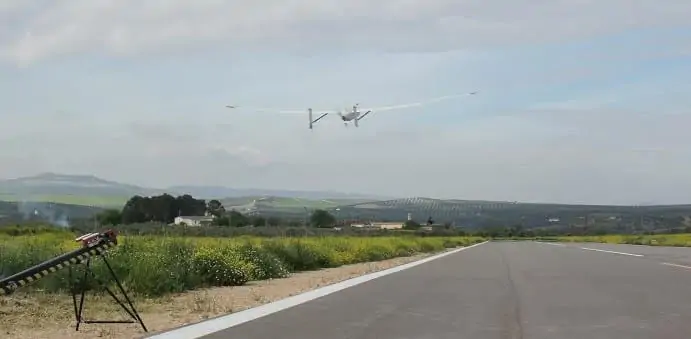The European ARIADNA consortium, led by information technology and defense systems company Indra, has announced that it has completed simultaneous flight tests in a conventional airport of a remotely piloted aircraft (RPAS) in the presence of a manned aircraft.
ARIADNA claims that the tests are some of the first flying operations undertaken in Europe involving operation of a drone in the area of traffic of a conventional airdrome. The ARIADNA project hopes to develop further progress in integrating drones into non-segregated airspace.
The flight program was held at the ATLAS Experimental Flight Center, located in Villacarrillo, Spain. This center has an associated airspace that can be segregated for such operations.
The exercises were carried out in two distinct phases. In the first, a drone, called Viewer, executed various maneuvers on the airfield while the Indra MRI P2006T manned aircraft operated simultaneously.
A controller supervised the operation, as in a real situation, giving separation instructions to the aircraft. The drone’s remote pilot, which monitors the aircraft from the ground at all times, had the position data of both aircraft provided by an ADS-B receptor, thus improving situational awareness of traffic in the area.
Another drone was used in the second phase of flights — the unmanned helicopter Logo — in order to validate the feasibility of instrumental approach and landing procedures with vertical guidance based on satellite navigation. The ability of these aircraft to operate at an airport under the same conditions as other aircraft was thus demonstrated.
The ARIADNA project has been developed by a consortium of companies and institutions in the Spanish aeronautical sector, composed of Indra as coordinator and industrial partner of RPAs; ENAIRE as manager of Air Navigation in Spain; CRIDA, as a research center in air traffic management; and FADA-CATEC, as a research center and RPAs operator.
The project is one of several demonstrations co-funded by the SESAR Joint Undertaking aimed at safely integrating drones into the European ATM system. SESAR (Single European Sky Air Traffic Management Research) was set up to modernise and harmonise ATM systems through the definition, development and deployment of innovative technological and operational solutions.
Established in 2007, the SESAR Joint Undertaking (SJU) is a public-private partnership which pools the knowledge and resources of the entire ATM community in order to define, research, develop and validate SESAR Solutions. Founded by the European Union and Eurocontrol, the SJU currently has 15 members who together with their partners and affiliate associations represent over 80 companies working in Europe and beyond. The SESAR JU also works closely with staff associations, regulators, airport operators, and the scientific community.
In 2014, the SESAR Deployment Manager (SDM), comprised of air navigation service providers, airlines and the SESAR-related Deployment Airport Operators Group (SDAG), coordinated the implementation of the EU’s Pilot Common Project, the first set of SESAR Solutions to be deployed in a synchronised and timely manner across Europe.



















